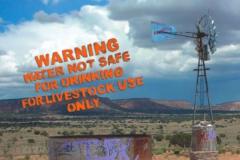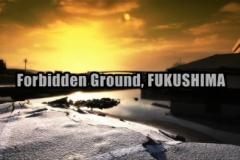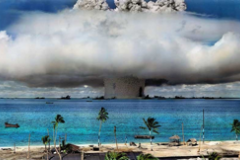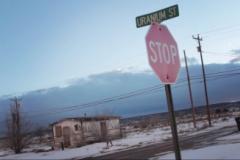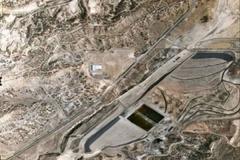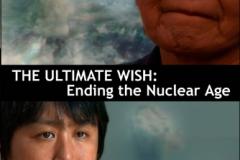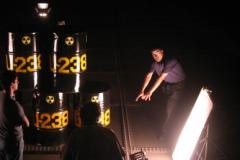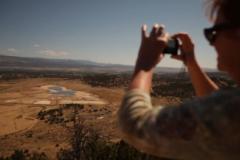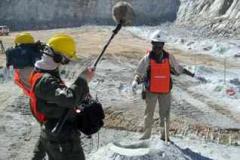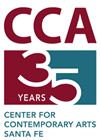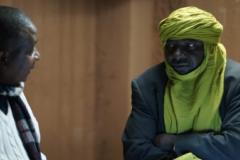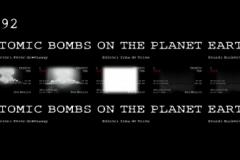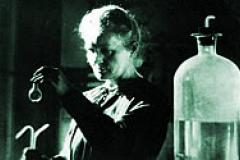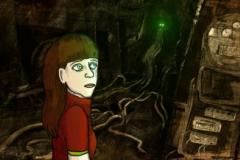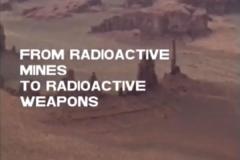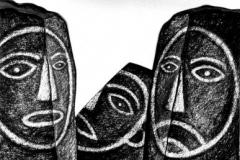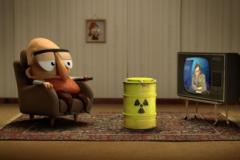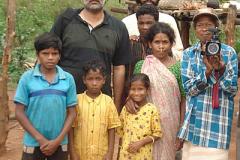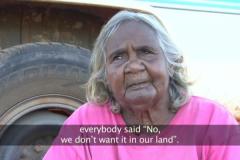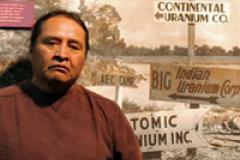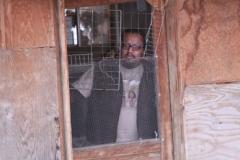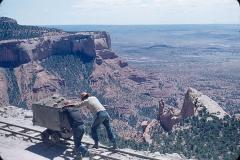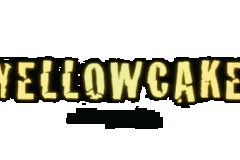ALBUQUERQUE - NOV. 27 TO 28
Guild Cinema, Albuquerque
3405 Central Avenue NE Albuquerque, NM - (505) 255-1848
$5 students with ids / $7 general per block of movies or features
Germany, 2012, 4 min, no dialogue
Animation
World Premiere
Animated short film about Fukushima children who can't play outside. About their dreams and realities.
Bachelor in 2012 of Shoko Hara and Paul Brenner
Sound design and Music: Lorenz Schimpf
Teachers: Prof. Klaus Birk, Alexander Hanowski, Martin Hesselmeier
DHBW Ravensburg, Studiengang Mediendesign
Director Paul Brenner present, Munich 2013
Japan, 2012, 65 min, English subtitles
World Premiere
A documentary that captures everyday life at a special nursing home for elderly atomic bombing survivors over the course of two years. Its director is Sakaguchi Katsumi, who has received high praise for his works such as "Sleep" (Nemuriyusurika). A facility for aged atomic bombing survivors exists in Nagasaki City called the Meguminooka Nagasaki Genbaku Home (Grace hill Nagasaki atom bomb home). To pass on their knowledge, the residents themselves put on plays based on their own experiences of the atomic bombing of Nagasaki for children who visit the home. This documentary sheds light on these atomic bombing victims as they struggle with the pain they bear and live with fierce determination.
(Atomny Ivan)
Russia, 2012, 91 min, Russian, English subtitles
Production: Telesto Film Company
Romantic Comedy
That is a plane story of people from the future which is getting to be real nowadays. The heroes are beautiful and helpless, but they continue to fight for their own happiness and purport. The story takes place in the town where the nuclear engineer may live in one apartment with his mother, the nuclear engineer and his grand-mother – the pioneer of nuclear industry. The story is really outstanding, it is about Ivan and Tania, Tania is interested in her science carrier and Ivan is not interested in anything, but Tania. The new third hero makes heroes to wake up. A lyrical comedy.
Producer Victoria Gromik present, Munich 2013
(Dii'go To Baahaane)
USA | 2012 | 33 min | Documentary
Directors: Deborah Begel and David Lindblom
Executive Producers: Dr. Johnnye Lewis and Chris Shuey
Original language : Navajo & English | Subtitles: English
This documentary is a four part meditation on the Navajo people’s problems with contaminated drinking water. Nearly one out of three people in the Navajo Nation struggle with this issue. Four Stories About Water opens with a waterfall of people who reveal the scope of water contamination problems on Navajo lands, from the health problems that were likely caused by uranium tailings left uncovered to the view of water as “a spiritual element” to the fact that 30% of the Navajo people don’t have access to safe water. «For us Diné people, if we treat water with respect and have spiritual faith, water will respect us. In this way, we will go forward in a balanced and harmonised life. » David Begay
Japan, 2012, 57 min, Japanese, English subtitles
Documentary
World Premiere
It is a documentary on the aftermath of the disaster in Fukushima.
Someone said "Fukushima, it's like a parallel world". It's another world. Apparently, from the outside, everything looks normal. Outside the exclusion zone of 20km, life continues as before, but not quite, this is only an appearance. The danger is invisible. My challenge is: how to make visible what is invisible.
USA | 2012 | 87 min | Documentary
Director: : Adam Jonas Horowitz
Original Language: Marshallese & English | Subtitles: French / Spanish
Featuring recently declassified U.S. government documents, survivor testimony, and unseen archival footage, Nuclear Savage uncovers one of the most troubling chapters in modern American history: how Marshall islanders, considered an uncivilized culture, were deliberately used as human guinea pigs to study the effects of nuclear fallout on human beings.
Between 1946 and 1958 the United States tested 67 nuclear weapons above ground on or near Bikini and Enewetok atolls. The hydrogen bomb was 1000 times more powerful than the Hiroshima bomb. Entire islands were vaporized and populated islands were blanketed with fallout. As the film shows, the heavily exposed people of Rongelap were then enrolled as human subjects in the top-secret Project 4.1 and evacuated to a severely contaminated island to study the effects of eating radioactive food for nearly 30 years. Many of the Marshall Islanders developed cancers and had babies that were stillborn or with serious birth defects.
Nuclear Savage follows the islanders today as they continue to fight for justice and acknowledgement of what was done to them. Despite recent disclosures, the U.S. government continues to deny that the islanders were deliberately used as human guinea pigs. The film raises disturbing questions about racism, the U.S. government’s moral obligation to the people of the Marshall Islands, and why the government is continuing to cover up the intent of the tests and Project 4.1 after several decades.
Awards:
AUDIENCE AWARD, Best Film Cinema Planeta International Festival, Mexico
JURY PRIZE, Best Feature Documentary, Paris/FIFE International Festival of Environmental Films
JURY PRIZE, Chicago Peace on Earth Film Festival
YELLOW OSCAR, Best Feature Documentary, International Uranium Film Festival Rio 2013
More information:
http://ncronline.org/blogs/eco-catholic/yellow-oscar-goes-documentary-ex...
http://www.veteranstoday.com/2014/01/24/americas-nuclear-radiation-cover...
http://www.globalresearch.ca/media-coverup-of-impacts-of-u-s-nuclear-wea...
USA, 2012, 12 min, English
Documentary
Just outside Grants, New Mexico, is a 200-acre heap of toxic uranium waste, known as tailings. After 30 years of failed cleanup, the waste has deeply contaminated the air and water near the former uranium capital of the world. TAILINGS is a cinematic investigation into the pile that is gravely shaping the lives of those who are stuck living in its shadow.
TRAILER: http://tailingsfilm.com
TAILINGS won the Best New Mexico Short Award of the Santa Fe Independent Film Festival.
USA, 2011, 92 min, English
In 2010, the United States announced the first new nuclear power plant construction in over 32 years. The "Nuclear Renaissance" was born, and American's long stared expasion of nuclear energy was infused with new life.
USA, 45 min
Director's Comments after the film
This illuminating film documents the largest radioactive waste spill in U.S. history - a national tragedy that received little attention. With the sound of a thunderclap, 94 million gallons of water contaminated with uranium mining waste broke through a United Nuclear Corporation storage dam in 1979. The water poured into the Puerco River in New Mexico - the main water supply for the Navajo Indians that live along the river, and a tributary of the major source of water for L.A. Navajo ranchers, their children, and farm animals waded through the river unaware of the danger.
The River That Harms tells the story of this tragedy and the toll it continues to take on the Navajos, who lost the use of their water. To the Navajos, this event is also a prophetic warning for all humanity.
USA, 2012,40 min, English/Japanese/French, English subtitles
Co-production Kathleen Sullivan
Documentary
Moving, unforgettable living witnesses who survived two of the world's most momentous radiation crises: Nagasaki in 1945 and Fukushima in 2011.
They are interlaced with nuclear experts and archival footage, some shocking, illuminating the largely unrecognized connection between nuclear weapons and nuclear power, and the growing global movements to abolish both.
The documentary is both a tragic and an inspirational example of courageous women in the face of environmental catastrophes and an alert to everyone today about the dangers of continued nuclear proliferation and nuclear power.
http://richtervideos.com/TheUltimateWish/
Director will be present (New York 2014)
(Uranio 238: La Bomba Sucia del Pentágono)
Costa Rica, 2009, 28 min, English, Spanish subtitles
Producer Isabel Macdonald and San José Quaker Peace Center
Documentary
Uranium 238 depicts the hazards that the use of depleted uranium or DU in conventional weapons poses for the health of soldiers and civilians. Through interviews with soldiers, scientists and activists, the documentary explores the health hazards when this radioactive and toxic material is ingested or inhaled by people in the battle fields and shooting ranges. Based in scientific data this video has been used by the International Coalition to Ban Uranium Weapons (ICBUW) as part of its international campaign to prohibit DU as a military component.
URANIUM 238 - The Pentagon´s Dirty Pool won the Jury Award as the Best Short Film of the First International Uranium Film Festival 2011.
USA, 2012, 70 min
Production: Reelthing
The promise of jobs from a proposed uranium mill has an economically devastated mining community in Colorado hopeful for the first time in decades. When environmentalists step in to stop the mill, pro-mill advocates are enraged. A debate ensues, pitting jobs against health and the environment.
Without judgment, both sides of the issue are brought to life in heart-wrenching detail as the film follows conflicting visions for the future. The film offers no easy answers but aims instead to capture personal stories and paint a portrait of the lives behind this nuanced and complex issue.
Site: http://www.uraniumdrivein.com/
Germany | 2010/2014 | 35 min (Short version) | Documentary
Director: Joachim Tschirner
Original Language: English
Web site: www.umweltfilm.de
This new short version of the feature documentary "Yellow Cake. The dirt behind Uranium" focuses on a secret uranium mine in East Germany, that produced for decades yelllow cake for the Sovjet Union's atomic bombs. It was the third largest uranium mine in the world, located in the provinces of Saxony and Thuringia. Operating until the Reunification, it had the code name WISMUT - German for bismuth. The film tells the history of the Wismut and accompanies for several years the first clean-up operation in the history of uranium mining.
Film website: www.yellowcake-derfilm.de
Awards:
YELLOW OSCAR, Best Short Documentary, International Uranium Film Festival Rio 2014
SANTA FE - NOV. 30 & DEC. 1
Center for Contemporary Arts Cinematheque
1050 Old Pecos Trail
Santa Fe, NM 87505
Phone: 505.982.1338
Email: contact@ccasantafe.org
http://www.ccasantafe.org/events
http://www.ccasantafe.org/cinematheque/show-times
Germany, 2012, 4 min, no dialogue
Animation
World Premiere
Animated short film about Fukushima children who can't play outside. About their dreams and realities.
Bachelor in 2012 of Shoko Hara and Paul Brenner
Sound design and Music: Lorenz Schimpf
Teachers: Prof. Klaus Birk, Alexander Hanowski, Martin Hesselmeier
DHBW Ravensburg, Studiengang Mediendesign
Director Paul Brenner present, Munich 2013
Germany, 2013, 90 min, German
Documentary
The film reveals the hidden agenda of the nuclear industry in Africa and the alarming consequences for people and the environment. In collusion with corrupt governments and questionable business partners energy companies source uranium for their domestic markets. And – faced with an apparent "sales problem" of nuclear technology in the Western world – they also lobby African governments to buy nuclear power plants.
Otherwise well informed high-level decision makers in Africa seem oblivious to the risks of nuclear power. They happily welcome the prospect of a seemingly endless, cheap and clean energy source. And their national pride is fuelled by the fact that the radioactive raw material for the new reactors doesn't need to be imported from other countries – it's hidden in the African soil.
Anti-nuclear activists in Africa are intimidated, persecuted and sometimes killed. In this film, critics of the nuclear industry speak out against the injustice and reveal the dubious activities of nuclear enterprises - from the illegal exploitation of the mines in the Congo to the controversial mining operations in the Sahara region. We travel through the desert on the "Uranium Highway" and show how the current war in Mali is related to fifty years of uranium mining that have destroyed people's livelihoods and pushed them into the hands of Al-Qaeda terrorists.
The film shows the dilemma of the African continent: It desperately needs cheap and reliable electric power for its development - but instead of being able to use its own resources, Africa is forced to sell off its riches to corrupt multinational enterprises. The sobering conclusion: In the future, African governments will need to give up their unrealistic nuclear ambitions and develop appropriate technologies to free themselves from their technological dependence on Western enterprises.
Filmwebsite: www.a-o-buero.de/en/films/filme/datum/2013/05/31/atomic-africa/
UK/The Netherlands | 2011 | 13 min | Art & Experimental documentary
Director: Peter Greenaway, Video Design Irma de Vries
Producer: Change Performing Arts www.changeperformingarts.com | Language: Multilingual
Synopsis: Very surprisingly from 1945 to 1989 there have been 2201 atomic bombs dropped on the planet Earth - an astonishing number of atomic bombs implying huge destruction and fall-out. The film shows evidence of every bomb explosion documented with the nation responsible, the date and location, the force and the height about earth or sea level in a relentless build up of accumulating destruction that is both inspiring and dreadful in the true biblical sense of the phrase - full of dread.
Video: https://www.youtube.com/watch?v=Mc3EKAszRAw
Awards: International Uranium Film Festival Hors Concours Award, Rio de Janeiro 2012
USA, 2010, 73 min, English
Documentary
Latin American Premiere
Yellow Oscar Best Feature Film 2012
For much of the twentieth century the United States Department of Defense was a major producer of radioactive waste. The Pentagon not only produced its own nuclear waste. For years, the Pentagon depended on an unknown number of private defense contractors to supply countless radioactive parts and equipment. In the mid-twentieth century, the U.S. government actually gave some of these defense contractors permission to dump radioactive waste on their private properties.
The Pentagon seldom, if ever, disclosed the whereabouts of these dangerous nuclear dumps. The problem becomes one for the ages: many of these radioactive isotopes remain dangerous and "hot" for thousands of years, even as the radiation is invisible to unsuspecting victims.
This carelessness caught up with college students in Lock Haven, Pennsylvania. One day the students woke up to find environmental officials dressed in protective "moonsuits" searching their apartment building for tell-tale signs of radioactive waste.
USA | 2012 | 87 min | Documentary
Director: : Adam Jonas Horowitz
Original Language: Marshallese & English | Subtitles: French / Spanish
Featuring recently declassified U.S. government documents, survivor testimony, and unseen archival footage, Nuclear Savage uncovers one of the most troubling chapters in modern American history: how Marshall islanders, considered an uncivilized culture, were deliberately used as human guinea pigs to study the effects of nuclear fallout on human beings.
Between 1946 and 1958 the United States tested 67 nuclear weapons above ground on or near Bikini and Enewetok atolls. The hydrogen bomb was 1000 times more powerful than the Hiroshima bomb. Entire islands were vaporized and populated islands were blanketed with fallout. As the film shows, the heavily exposed people of Rongelap were then enrolled as human subjects in the top-secret Project 4.1 and evacuated to a severely contaminated island to study the effects of eating radioactive food for nearly 30 years. Many of the Marshall Islanders developed cancers and had babies that were stillborn or with serious birth defects.
Nuclear Savage follows the islanders today as they continue to fight for justice and acknowledgement of what was done to them. Despite recent disclosures, the U.S. government continues to deny that the islanders were deliberately used as human guinea pigs. The film raises disturbing questions about racism, the U.S. government’s moral obligation to the people of the Marshall Islands, and why the government is continuing to cover up the intent of the tests and Project 4.1 after several decades.
Awards:
AUDIENCE AWARD, Best Film Cinema Planeta International Festival, Mexico
JURY PRIZE, Best Feature Documentary, Paris/FIFE International Festival of Environmental Films
JURY PRIZE, Chicago Peace on Earth Film Festival
YELLOW OSCAR, Best Feature Documentary, International Uranium Film Festival Rio 2013
More information:
http://ncronline.org/blogs/eco-catholic/yellow-oscar-goes-documentary-ex...
http://www.veteranstoday.com/2014/01/24/americas-nuclear-radiation-cover...
http://www.globalresearch.ca/media-coverup-of-impacts-of-u-s-nuclear-wea...
USA, 2011, 17 min, English subtitles
Experimental
Twelve fictional time-travelers explore the post-atomic age American West, when they discovered the abandoned tunnels beneath Yucca Mountain Radioactive Waste Repository, in this sixteen-minute long Experimental SciFiction Punk Western.
WINDOW ROCK - DEC. 2 TO 4
Navajo Nation Museum
Highway 264 and Loop Road
Phone: +1.928.871.7941
Email: info@navajonationmuseum.org
http://www.navajonationmuseum.org/
1050 Old Pecos Trail
Santa Fe, NM 87505
Phone: 505.982.1338
Email: contact@ccasantafe.org
http://www.ccasantafe.org/events
http://www.ccasantafe.org/cinematheque/show-times
Germany, 2012, 4 min, no dialogue
Animation
World Premiere
Animated short film about Fukushima children who can't play outside. About their dreams and realities.
Bachelor in 2012 of Shoko Hara and Paul Brenner
Sound design and Music: Lorenz Schimpf
Teachers: Prof. Klaus Birk, Alexander Hanowski, Martin Hesselmeier
DHBW Ravensburg, Studiengang Mediendesign
Director Paul Brenner present, Munich 2013
Australia, 2005, 62 min, English
Production: Frontline Film Foundation
Documentary
Latin American Premiere
Blowin' in the Wind examines the secret treaty that allows the US military to train and test its weaponry on Australian soil. It looks at the impact of recycled uranium weapons and the far-reaching physical and moral effects on every Australian. The film's release has been timely as the government currently moves to approve more uranium mines while arguing the contrary - that by going nuclear we are being both 'safe' and 'green'. The film reveals that Iraqi babies are now being born with major birth defects. Bradbury wonders whether Australians living downwind from the military testing ranges will be next. He argues that we were lied to by the British over the Woomera and Maralinga atomic tests. Can we trust another equally powerful partner in our 'war on terror'?
With a cash budget of just $12,000 the film raises pertinent questions which cannot be ignored by the Australian public. The film shocked, angered and surprised large audiences when shown at the Sydney and Brisbane Film Festivals.
www.frontlinefilms.com.au/videos/blowin.htm
(Dii'go To Baahaane)
USA | 2012 | 33 min | Documentary
Directors: Deborah Begel and David Lindblom
Executive Producers: Dr. Johnnye Lewis and Chris Shuey
Original language : Navajo & English | Subtitles: English
This documentary is a four part meditation on the Navajo people’s problems with contaminated drinking water. Nearly one out of three people in the Navajo Nation struggle with this issue. Four Stories About Water opens with a waterfall of people who reveal the scope of water contamination problems on Navajo lands, from the health problems that were likely caused by uranium tailings left uncovered to the view of water as “a spiritual element” to the fact that 30% of the Navajo people don’t have access to safe water. «For us Diné people, if we treat water with respect and have spiritual faith, water will respect us. In this way, we will go forward in a balanced and harmonised life. » David Begay
Germany, 2013, 10 min, English
World Premiere
Behind the power outlet in her room the little girl discovers a futuristic fairground run by the nuclear energy industry. Soon her fascination turns into horror. There is no way back, the catastrophe is near. The Fukushima nuclear accident is blueprint for the story: a society, confronted with the sudden disaster, acting like headless chicken - those responsible send their apologies.
Realisation: Ilinca Höpfner, Helge Henning
Narrator: Nick Cave
Soundediting: Sid Gautama
Producer: Ingmar Böschen
Germany 2013
USA, 1999, 25 min
Co- Producers / Directors / Writers (with Anna Rondan)
This film chronicles how three large communities of people are effected by uranium's cycle of destruction: the Navajo uranium miners of the American Southwest. They mined for uranium that led to a cancer epidemic which also affects the surrounding communities. The Gulf War Veterans, and today's exposed troops affected by depleted uranium residue in Iraq, and the Iraqi people and environment against whom Depleted Uranium bullets and shells are used. Evidence released here shows that the continued presence of U-238 was being measured in the urine of war veterans 8-9 years after the Gulf war.
USA | 1997 | 9 min | Animation
Director: Karen AQUA (1954 - May 30th, 2011) | Music by Ken Field
Language: No Dialogue
Synopsis: In south-central New Mexico, an ancient Native American rock art site lies 35 miles from the detonation site of the world’s first atomic bomb. The juxtaposition of these sites points to the striking contrast between the two worlds which created them: one which reveres and lives in harmony with the natural world, and one which, in striving to control the forces of nature, has created a means for its destruction. Film director's website: http://karenaqua.com
Awards:
Humboldt International Film Festival, CA, 1998: 1st Prize, Animation
Marin County National Festival of Short Films, CA, 1998: 1st Prize, Animation
Green Extreme Film Festival, Canada, 1999: Best Environmental Film
Prix Leonardo, Italy, 1999: Gold Certificate
International Uranium Film Festival SPECIAL ACHIEVEMENT AWARD 2012
(Herr Hoppe und der Atommüll)
Germany, 2011, 4 min
Producer Filmakademie Baden – Württemberg
Animation
A barrel of nuclear waste drops into the living room of Herr Hoppe an average suburbian German. He has to get rid of it and does it in his own wacky way.
India | 2009 | 9 min | Documentary
Director: Shri Prakash
Original Language: English
Jadugoda is an area in the state of Bihar populated by Adivasi (tribal peoples of India). It first came into prominence when uranium deposits were discovered in the area, since Jadugoda is India's only underground uranium mine. The film documents the devastating effects of uranium mining by Uranium Corporation of India Limited in Jadugoda. For the last thirty years, the radioactive wastes have been just dumped into the rice field of the Adivasis.
Film website: http://shriprakash.com/films/jaadugoda-the-black-magic
Australia, 2010, 10 min
Documentary
Muckaty Voices is a short film capturing Aboriginal community resistance to an Australian government plan to dump low and long lived intermediate level radioactive waste at Muckaty Station, 120km north of Tennant Creek in the Northern Territory. The government's push for Muckaty has sparked widespread criticism from the targeted community, trade unions, national health and environment groups and Indigenous organizations. A federal court challenge has been launched to contest the Muckaty nomination. The film presents the country and community affected by this proposal.
The film was produced for the Muckaty Traditional Owners by Enlightning Productions, with support of Beyond Nuclear Initiative: www.beyondnuclearinitiative.com
USA | 2012 | 87 min | Documentary
Director: : Adam Jonas Horowitz
Original Language: Marshallese & English | Subtitles: French / Spanish
Featuring recently declassified U.S. government documents, survivor testimony, and unseen archival footage, Nuclear Savage uncovers one of the most troubling chapters in modern American history: how Marshall islanders, considered an uncivilized culture, were deliberately used as human guinea pigs to study the effects of nuclear fallout on human beings.
Between 1946 and 1958 the United States tested 67 nuclear weapons above ground on or near Bikini and Enewetok atolls. The hydrogen bomb was 1000 times more powerful than the Hiroshima bomb. Entire islands were vaporized and populated islands were blanketed with fallout. As the film shows, the heavily exposed people of Rongelap were then enrolled as human subjects in the top-secret Project 4.1 and evacuated to a severely contaminated island to study the effects of eating radioactive food for nearly 30 years. Many of the Marshall Islanders developed cancers and had babies that were stillborn or with serious birth defects.
Nuclear Savage follows the islanders today as they continue to fight for justice and acknowledgement of what was done to them. Despite recent disclosures, the U.S. government continues to deny that the islanders were deliberately used as human guinea pigs. The film raises disturbing questions about racism, the U.S. government’s moral obligation to the people of the Marshall Islands, and why the government is continuing to cover up the intent of the tests and Project 4.1 after several decades.
Awards:
AUDIENCE AWARD, Best Film Cinema Planeta International Festival, Mexico
JURY PRIZE, Best Feature Documentary, Paris/FIFE International Festival of Environmental Films
JURY PRIZE, Chicago Peace on Earth Film Festival
YELLOW OSCAR, Best Feature Documentary, International Uranium Film Festival Rio 2013
More information:
http://ncronline.org/blogs/eco-catholic/yellow-oscar-goes-documentary-ex...
http://www.veteranstoday.com/2014/01/24/americas-nuclear-radiation-cover...
http://www.globalresearch.ca/media-coverup-of-impacts-of-u-s-nuclear-wea...
USA, 2007, 37 min
Director: Jenny Pond, produced by Norman Patrick Brown & Jenny Pond.
Advisor: Manuel Pino, Recipient of the Nuclear Free
The film tells the story of a corrupt government, unconscionable greed and a policy of destruction aimed at the Aboriginal Homelands of Indigenous People from the 1940's until today. It is a documentary about uranium mining and the devastating effect it has on the people, livestock, water and agriculture in the 4 Corners area of the US and the Grand Canyon. The path of POISON WIND has taken us to political and environmental activists within the Navajo Nation (Diné) and Pueblo People (Acoma and Laguna) of New Mexico, Western Shoshone, Hualapai and Havasupai where today many people suffer relentlessly from the effects of living near radiation contaminated lands. POISON WIND highlights the greed of mining companies that set out to destroy the balance of life created by the people of these lands...sacred to so many and offering only a death sentence in the end. This film is a "Visual Oral History" which comes from the people themselves and only serves to focus on their stories, as they speak from their hearts about how uranium mining left them victims of where they live.
Future Award 2008
Info: Poisonwindmovie.wordpress.com
USA, 2011, 30 min, English
Producer: Yvonne Latty
Documentary
Latin American Premiere
"Sacred Poison" is a 30-minute documentary that brings viewers into the pain and devastation that uranium mining brought into the lives of too many Navajo. It is a moving documentary whose power is in the voices and the people that we meet. It is raw and intimate, and I use what I learned from years of reporting, my journalism, to bring their stories to life. The usually reserved Navajo reveal the pain and struggle of living life where the amount of clean water you have to drink is very limited, where one family lost seven children to uranium contamination, where various forms of cancer seem to live inside so many neighbors.
TRAILER
http://sacredpoison.com
USA, 2012, 12 min, English
Documentary
Just outside Grants, New Mexico, is a 200-acre heap of toxic uranium waste, known as tailings. After 30 years of failed cleanup, the waste has deeply contaminated the air and water near the former uranium capital of the world. TAILINGS is a cinematic investigation into the pile that is gravely shaping the lives of those who are stuck living in its shadow.
TRAILER: http://tailingsfilm.com
TAILINGS won the Best New Mexico Short Award of the Santa Fe Independent Film Festival.
USA, 2011, 92 min, English
In 2010, the United States announced the first new nuclear power plant construction in over 32 years. The "Nuclear Renaissance" was born, and American's long stared expasion of nuclear energy was infused with new life.
USA, 1983, 58 min, English
Production: Sacred Land Film Project
The Four Corners: A National Sacrifice Area? Examines the cultural and environmental impasse of energy development in Arizona, New Mexico, Colorado and Utah. The film takes its title from a National Academy of Sciences report that concluded that strip-mining in the arid Colorado Plateau could permanently damage the land, creating a "national sacrifice area." Four Corners explores the hidden costs of uranium mining and milling, coal strip-mining and oil shale extraction in the "Golden Circle of National Parks" – the homeland of Hopi, Navajo and Mormon cultures.
USA, 45 min
Director's Comments after the film
This illuminating film documents the largest radioactive waste spill in U.S. history - a national tragedy that received little attention. With the sound of a thunderclap, 94 million gallons of water contaminated with uranium mining waste broke through a United Nuclear Corporation storage dam in 1979. The water poured into the Puerco River in New Mexico - the main water supply for the Navajo Indians that live along the river, and a tributary of the major source of water for L.A. Navajo ranchers, their children, and farm animals waded through the river unaware of the danger.
The River That Harms tells the story of this tragedy and the toll it continues to take on the Navajos, who lost the use of their water. To the Navajos, this event is also a prophetic warning for all humanity.
USA, 2012,40 min, English/Japanese/French, English subtitles
Co-production Kathleen Sullivan
Documentary
Moving, unforgettable living witnesses who survived two of the world's most momentous radiation crises: Nagasaki in 1945 and Fukushima in 2011.
They are interlaced with nuclear experts and archival footage, some shocking, illuminating the largely unrecognized connection between nuclear weapons and nuclear power, and the growing global movements to abolish both.
The documentary is both a tragic and an inspirational example of courageous women in the face of environmental catastrophes and an alert to everyone today about the dangers of continued nuclear proliferation and nuclear power.
http://richtervideos.com/TheUltimateWish/
Director will be present (New York 2014)
USA, 2010, 11 min
Executive Productions: First Nations Development Institute, Seventh Generation Fund, Western Action Mining Network, Navajo Waters
Documentary
The waters and health of Native and non-Native communities near the Grand Canyon and across the Southwest have been contaminated by decades of uranium mining and milling. Today, thousands of new uranium mining claims have been filed on the Colorado River Watershed, and directly threaten the water supplies of 25 million people. Join us in a conversation to help us understand more about Uranium.
(Uranio 238: La Bomba Sucia del Pentágono)
Costa Rica, 2009, 28 min, English, Spanish subtitles
Producer Isabel Macdonald and San José Quaker Peace Center
Documentary
Uranium 238 depicts the hazards that the use of depleted uranium or DU in conventional weapons poses for the health of soldiers and civilians. Through interviews with soldiers, scientists and activists, the documentary explores the health hazards when this radioactive and toxic material is ingested or inhaled by people in the battle fields and shooting ranges. Based in scientific data this video has been used by the International Coalition to Ban Uranium Weapons (ICBUW) as part of its international campaign to prohibit DU as a military component.
URANIUM 238 - The Pentagon´s Dirty Pool won the Jury Award as the Best Short Film of the First International Uranium Film Festival 2011.
(Uranium, l'héritage empoisonné)
France | 52 min | Documentary
Director: Dominique Hennequin | Producer: Nomades TV
Language: French and English
Synopsis: A shocking investigation into uranium mining in Africa. We visit three areas affected by the uranium industry; Mounana where activity has now ceased, Arlit, where the mines have been active for 40 years, and Imouraren, a future site. French energy giant Areva pulled out of Mounana, Gabon, in 1999. The uranium mine, Comuf, was closed down and covered over. In fact, at a glance, it’s almost as if the mine never existed. However, Mounana suffers from extremely dangerous levels of radioactive pollution. The soil and the rivers are toxic; even the houses have a Geiger count as much as 8 times the safe limit. They were built using radioactive material.
In Arlit, North Niger, we encounter similar problems, including an abnormally high incidence of lung cancer. Now that Areva has left, the former miners are left to pay for their own health care. In spite of the horrific damage to local populations at previous sites, another mine is being constructed, in Imouraren. The result of a colossal deal between the governments of France and Niger, this will be their biggest open mine yet. Areva claims that the new mine will not poison the land, but local people are sceptical.
Film website: http://www.javafilms.fr/spip.php?article311
USA, 2009, 10 min
Production: Boxcar Films
From Exploration to fuel production, this documentary relates the contamination, water consumption, waste generation, costs to the American taxpayer through government subsidies, health impacts,and the CO2 emissions that are caused by the front end of the nuclear fuel cycle. Each phase has its own devastating impact on the environment and the surrounding population, from socioeconomic to health and safety. This film takes a deeper look into the facts that are, all too often, left unsaid. America is going "Down the Yellowcake Road," but given this information, shouldn't we ask the necessary question: Is this what we really want? This short documentary was created by Boxcar Films in 2009 to explore the frontend of the nuclear fuel production cycle. The short was funded by Colorado Citizens Against Toxic Waste.
www.boxcarfilms.com
Film info: www.downtheyellowcakeroad.org




